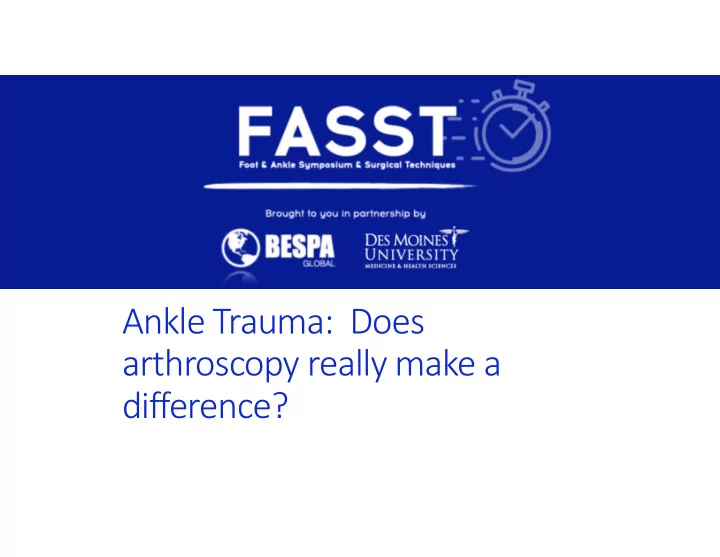

Ankle Trauma: Does arthroscopy really make a difference?
Disclosure • BESPA – Owner • Extremity Medical – Consultant • Nextremity – Consultant
Types of Ankle Fractures ‐ Historical • Malleolar • Lateral, Medial, Posterior • Bi/Trimalleolar • Pilon • Salter Harris • Tillaux • Nondisplaced • Displaced • If you can see a fracture line it is displaced
Mechanism of Injury • Low energy • Twisting • Direct blow • Fall • High Energy • MVA • Fall from height
Complexity • How did the fracture occur • Severity of displacement at time of injury • Was the joint loaded? • Pressing brake pedal • Stepped off the curb • Impaction injury • Soft tissue impingement preventing reduction
Cartilage injury • Was the mechanism of injury sufficient to cause cartilage injury • Shearing • Medial talar shoulder on inversion injury • Central talar dome lesion on eversion due to scraping on lateral tibia • Deltoid injury or medial malleolar fracture • Impaction • Fall from height • Brake pedal • Anterior/Posterior Tibia
Modalities • X‐ray • Bony anatomy • Alignment • CT • Identify more subtle fracture lines • Analyze the complexity of the fracture • Loose bone fragments • MRI • Cartilage injury • Ligamentous injury • Soft tissue interposition
Rationale for AORIF • 80% of malleolar fractures have a chondral injury • AO – fractures are reduced to restore articular congruity • Articular incongruity in the ankle is not well tolerated • Treatment of osteochondral lesions is often delayed • What damage is being caused by this delay • Impingement – decreased ROM • Additional cartilage damage
Fracture types ameniable to AORIF • Medial malleolar • Posterior malleolar • Tillaux • Triplane • Tibial Plafond
Timing • No surgery prior to 6 days • Let soft tissue heal and bleeding to subside • Ideal window is between 6‐12 days • Contradindications • Compromised soft tissue envelope • Excessive swelling +/‐ blisters • Arthroscopy fluid will extravasate into soft tissue ‐LR • Open fractures
AORIF technique • 4.0 mm 30 degree arthroscope • Fluid – gravity to 30 mmHg • Aggressive shaver • Slotted shaver • Reduction instruments • K‐wires • Cannulated screws
Anterior portals
Distraction – limit if possible
Posteriomedial portal
Fluoroscopy capability • Loose Body • Location of fracture • Reduction evaluation • Hardware placement
Bone fragments • Resist excising unless completely loose • Maybe hinged by cartilage • Reduce and prelinarily fixate
Cartilage tears • Should this be excised? • Will it heal itself? • How unstable is it? • Excise if unstable or loose
Microfracture
Arthroscopy Journal • Fibula fracture is extraarticular and fixated first • Camera inserted to verify reduction of medial malleolus fragment • Cartilage evaluated
Questions • Does the body absorb the cartilage fragments • Native ability of bone to heal • Does fluid pressures hamper healing • What is the definition of a good/excellent outcome?
64 y/o male – DOI 4 weeks ago
CT Scan
Scope images
Scope Images
Scope Images
Post Op
Recommend
More recommend